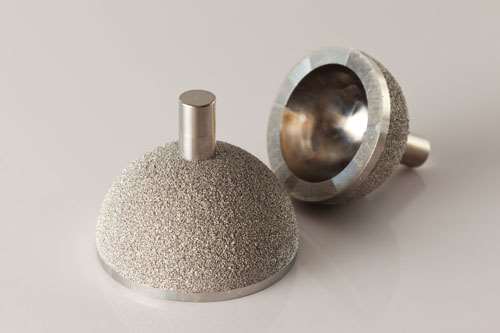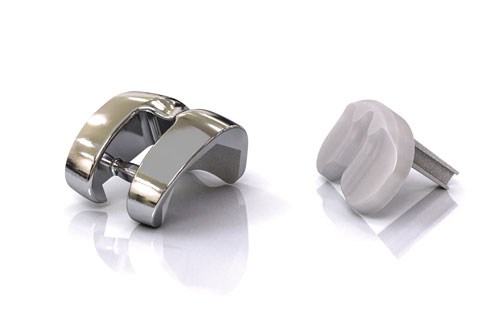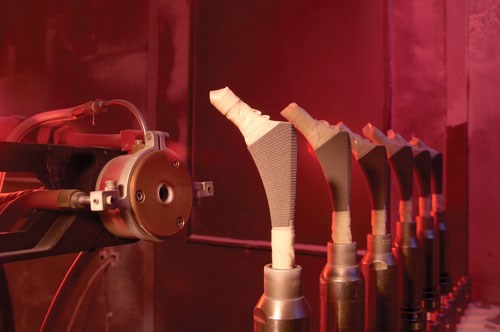Past, Present and Future of Medical Coatings
The journey to find balance between competitive, effective orthopedic implant coatings.
#medical #pollutioncontrol #masking
The school of thought surrounding most orthopedic implant coatings is that the more porous and “rough” the surface is, the better the implant will grip to and connect with the bone.
As a result of bone ingrowth, the implant will be more stable, requiring fewer repairs and repeat surgeries. But this mindset didn’t evolve overnight. And many still argue that “aggressive, highly porous” coatings are not applicable to many orthopedic implant situations.
Featured Content
In addition, there’s a reoccurring challenge in finding a balance between a coating’s cost and its effectiveness, and only a few orthopedic medical device companies have been able to adapt to the many advances in coating technology while still offering competitively priced solutions. By exploring the evolution of orthopedic medical device coatings, we can better appreciate the art and the science behind the coatings used today and what innovations lie ahead.
The Past
Twenty-five years ago, the particles (beads) used to form a coating were much larger than what’s used today. The challenge with larger beaded coatings is that they had minimal porosity, and the resulting surface was quite smooth. This was thought to limit the stability of the implant.
The need for higher porosity—and thus better bone ingrowth—led to the development of coatings formed with smaller beads. However, the issue of bone grip still remained.
Titanium plasma spray (TPS) coating was also a viable option at this time. Due to its application process, TPS resulted in a rougher, more “aggressive” coating surface. The challenge with TPS, however, was just the opposite of the small beaded coating: TPS lacked the porosity that beaded coatings offered.
A popular technique that evolved as a solution was to use the porous, beaded coating, but randomly distribute the final layer of beads to create a rough “stucco” effect. The end result, referred to as “scratch fit,” provided characteristics that were closer to what TPS provided, while still allowing space for bone ingrowth.
Then, about 10 years ago, metal foam products hit the market. Metal foam coatings are highly porous and produce a rougher surface. And because of their composition, standalone products can be made using this technique (e.g. an ankle wedge implant that’s completely foam). This diverse application differentiates a metal foam coating from a bead or TPS coating, but also makes it more expensive, which limits its marketability.
The Present
In recent years, trends in health care reform, reimbursement reductions, tighter budgets and the growing ambition to enter emerging markets like China and India have forced everyone to tighten the collective belt to maintain competitiveness.
Previous innovations like TPS and beaded coatings are still used today, but have evolved to use an asymmetric particle coating that’s become a popular present-day solution.
Asymmetric coatings essentially combine the stabilizing scratch-fit TPS, the high porosity metal foam, and the low cost of beaded coating. For example, one asymmetric coating now on the market for both cobalt chromium and titanium implants is highly porous (55 percent, ± 10 percent), with 300 ± 125μm pore size; and its ultimate tensile strength (UTS, or maximum stress that the material can withstand while being stretched or pulled) equals that of spherical bead coatings.
This type of coating is an impressive union of technologies that meet all of the requirements of today’s orthopedic implant market. Furthermore, it also enables select companies to offer a bone ingrowth coating solution at a price that’s attractive to low-cost markets like China and India.
In order to remain competitive in today’s market, coating solutions providers require a unique skill set: extensive in-house capabilities, high quality product, exceptional customer service and competitive pricing.
A medical coatings company must also be able to offer a diverse array of coating solutions for every orthopedic implant imaginable. This demands higher level technology, expertise, and an appreciation for more artistic forms of manufacturing.
In addition, a coating partner must be able to provide solutions above and beyond coating, such as design, engineering, and manufacturing. Such diversification and flexibility helps ensure that a design can be efficiently coated and manufactured, and prevents the customer from wasting time and money.
The Future
While past and present coating techniques have greatly enhanced the stability and effectiveness of orthopedic implants, new, impressive innovations promise even greater value.
Here are a few noteworthy ones on the horizon:
Antimicrobial coatings: The concept behind antimicrobial coatings is that they help fight infection. These types of coatings work by making the surface of the coating incompatible with harmful microorganisms that cause disease.
Antimicrobial elements are applied throughout the coating at a level dependent upon the chemistry used, for example: silver, organosilane compounds and iodine, to name a few. Each chemical compound has a unique mode of antimicrobial activity to combat bacteria, mold, mildew, and other infection-causing pathogens that tend to be especially rampant in private and public healthcare environments.
According to a 2012 market research report by Global Industry Analysts, Inc., the market is forecasted to reach U.S. $1.2 billion by the year 2017.
This growth is mainly driven by increasing demand from hospitals looking for ways to improve health, sanitation, and hygiene, reduce hospital-acquired infections and prevent the loss of valuable reimbursement dollars.
Direct Laser Metal Sintering: In a traditional medical device machining process, a manufacturer usually gets a metal piece (shaped like a cup, for example) and then puts the coating on it. With DLMS, a special machine employing a high-powered fiber optic laser creates a nearly complete product (a hip socket cup, for example) with the coating already on it.
This allows for highly complex geometries to be created in hours directly from 3D CAD data without any tooling. With no special tooling requirements, instead of making one unit at a time, a manufacturer can use DLMS for full production manufacturing, and as a cost-effective method to simplify assemblies and complex geometries.
Since most alloys can be used in the DLMS process, functional prototypes can be made out of the same material as production components. This enables more rigorous testing of prototypes while decreasing the development time for new products.
At present, DLMS is most suitable for companies that have a lot of customer diversity, as it grants them the ability to keep the machine running and experience a higher, faster return on investment, whereas small- to mid-sized companies with a more focused customer base may find a DLMS machine cost prohibitive.
Nanotech for Hydroxyapatite coating: The most important parameters for orthopedic implants, especially for weight-bearing joints that require a lot of movement, are that they have adequate wear resistance, allow for stable, secure bone attachment and promote elasticity and strength.
The solution to these requirements may lie in macro- and micro-textured implants that can be coated with nanoscale bone-like hydroxyapatite, the nanoplatelets that bone material is made of.
The idea behind using nanotechnology with hydroxyapatite coating is that it’s believed to enhance bioactivity and provide good adhesion between the implant and the bone.
With its relative ease of production and the ability to form a chemically and physically uniform coating over complex geometric shapes, nanocoating has opened up new opportunities to design superior biocompatible coatings for implants—including orthopedic implants made of material other than titanium or cobalt chromium, like plastics or pyrolytic carbon.
A Coat Above
The rise of orthopedic maladies over the past three decades—especially those associated with hips and knees—creates significant opportunity for medical device designers and manufacturers to improve not just implant technologies, but their coatings as well.
As hospitals grow increasingly cost-conscious, they are more inclined to invest in medical devices that support their ability to cost-effectively, reliably and safely enhance their patients’ quality of life.
Whether it’s hydroxyapatite coatings that use nanotechnology, asymmetric coatings that support stability and bone ingrowth, or antimicrobial coatings that help fight infection, the end goal remains the same: to elevate the performance of the orthopedic implant in the most effective, efficient way possible.
Orthopedic medical device companies that understand why implant coatings have evolved in the way they have are at an advantage. They are better positioned to offer solutions that balance cost and capability to their present and future coatings, and add more value to their customers.
Tony Crivella is the senior manager of implant sales at Orchid Orthopedic Solutions, a Holt, Michigan-based contract designer and manufacturer of implants, instruments and innovative technologies for the orthopedic, dental and cardiovascular markets. For more information about Orchid’s coating solutions, visit orchid-orthopedics.com.
RELATED CONTENT
-
Super Finishing: ‘Micro Machining Process’ Vital To Medical Industry
Using high-precision tools and technologies that smoothes a surface—or even intentionally leaves specific controlled amounts of roughness behind—MMP is unlike any treatment on the finishing market.
-
Functional Trivalent Chromium Electroplating of Internal Diameters
This paper discusses recent research work on the development of a functional trivalent chromium plating process from a trivalent-based electrolyte to replace hexavalent chromium plating. Hexavalent chromium plating has been used for many years to provide hard, durable coatings with excellent wear and corrosion resistance properties. However, hexavalent chromium baths have come under increasing scrutiny due to the toxic nature of the bath, effects on the environment and workers’ health. In this paper are results from our development program aimed at achieving properties comparable to existing hexavalent chromium plating for functional applications. Specifically, recent efforts in plating chromium on the internal surfaces of cylindrical parts will be presented, as well as wear test data.
-
Firearms and Flatware Feed Silvex’s Growing Electroplating Operation
It’s obvious that Silvex specializes in silver, but its processes also reach into the defense, aerospace, power generation and medical industries.





















